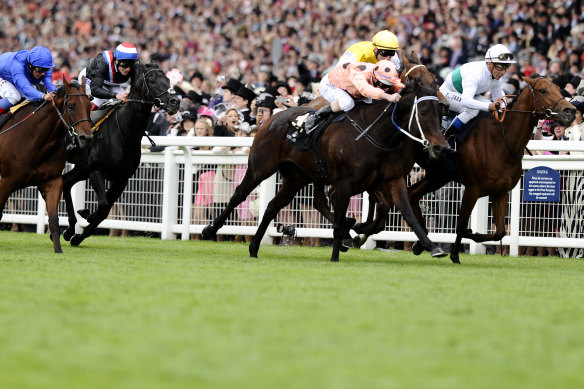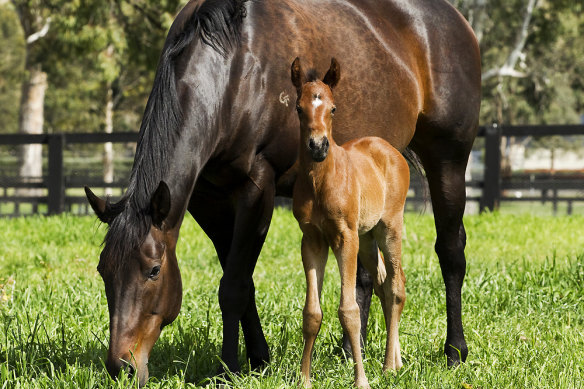‘Criticism is misplaced’: Breeders’ chief defends Black Caviar owners
By Adam Pengilly and Chris Roots
Thoroughbred Breeders NSW president Hamish Esplin has defended the owners of Black Caviar after social media posts suggested they had sacrificed the champion mare’s wellbeing in the pursuit of an intensive breeding program.
Black Caviar was humanely euthanised on Saturday, just hours after giving birth to a Snitzel colt, because of laminitis – inflammation of soft tissues that attach the foot to the hoof – which had stopped the blood flow to her feet.

Black Caviar wills herself to victory at Royal Ascot in 2012.Credit: Getty Images
Some questioned on social media if she had received the best possible care. After retiring from the track in 2013 with a perfect record of 25 wins from 25 starts, Black Caviar gave birth to nine foals in 11 years. She didn’t have a foal in the 2022 season, when she was given a year off. She died a day before her 18th birthday.
“The amount of expense, time and effort, and structures that go in place dedicated to purely keeping these animals healthy is mind-boggling,” Esplin explained.
“I would estimate that close to 100 per cent of every dollar spent by a breeder, like the owners of Black Caviar, post-racing would be spent purely trying to keep the animal healthy and fit. They want them to live a long and healthy life for as long as possible.
“It’s true they’re very valuable animals and their progeny can be very valuable, but case in point with the owners of Black Caviar, they decided not to sell any of their bloodstock. A criticism they’re in wholly for the money is misplaced, in this case.”

Black Caviar with her first foal, an Exceed And Excel filly, in 2014.
Black Caviar’s owners – the Madden, Hawkes, Wilkie, Taylor and Werrett families – remained close to the champion after she finished her racing career and would gather a couple of times a year at a Scone farm to see her together.
They would remember her deeds on the track, and the great mare would come and nuzzle up to each of them. They were intimate moments that reinforced the bond between horse and human.
Black Caviar was the only mare on the property that didn’t need an identification collar. Everyone knew who she was. When she developed mastitis – a bacterial infection of the milk ducts dangerous in horses as it often develops into laminitis – last week, she was rushed to Scone Veterinary Hospital. Mick Malone, the man who cared for her after she stopped racing, never left her side.
Malone and those closest to her are shattered at the loss of the great mare, who was like a member of his family.
“Because of the way their bodies are structured, they are on their feet for the better part of most of the day, and blood flow is critical to the foot,” Esplin said. “Laminitis is one of the most common ways animals die. You wouldn’t want any horse to suffer that condition.”
It was a desperately sad ending for Black Caviar. But she will be remembered for her perfect record on the track often overcoming injury, more often simply being the supreme athlete that couldn’t be matched.
Big winning margins showed the gulf in class between the mare and her top-class rivals, who would in turn go on to beat the rest by big margins once she retired.
Hay List would win three times at group 1 level, including a weight-carrying record in the Newmarket, while Buffering took five group 1 races after Black Caviar bowed out, including an Al Quoz at Dubai.
She went from Melbourne to Sydney to Brisbane and Adelaide as she became a national treasure and kept winning, before her memorable conquest of Royal Ascot in 2012.
Her win in the Diamond Jubilee Stakes was the narrowest of her career but the runner-up that day, Moonlight Cloud, won five group 1 races, including her next start in France by five lengths. Black Caviar mightn’t have been at her best in front of Queen Elizabeth, but she willed herself to win.
“She saved me,” said jockey Luke Nolen, who had dropped his hands on her in the final climb to the finish.
Her best in Australia was devastating. It came on her first trip to Randwick for the TJ Smith 2011, where Hay List was waiting. His trainer, John McNair was convinced he had her measure.
“I got up that morning thinking, ‘This is going to be the day’. He was flying,” McNair said. “I have never had a horse close to him. I have never seen a horse like her.”
Hay List skipped four lengths clear coming up the Randwick rise and McNair’s vision seemed set to become reality – until the big mare started to chase.
“I felt her coming and heard the crowd roar, and then she just went past me and away from me,” jockey Glyn Schofield said. “I didn’t think that could happen the way Hay List was going.”
In her peak years, the nation stopped when Black Caviar ran. She was that special – one of a kind. Winx would come along a couple of years later and break some of her records, but she never had Black Caviar’s aura of invincibility.
“I don’t know how I would have coped if Winx had stayed unbeaten,” trainer Chris Waller once said. “It is pressure only Peter Moody and his team know.”
Moody probably summed it up best on her retirement. “She’s been a great shining light for our industry and my career,” he said. “[So] let’s stop now before something can go haywire.”
Sports news, results, and expert commentary. Sign up for our Sport newsletter.